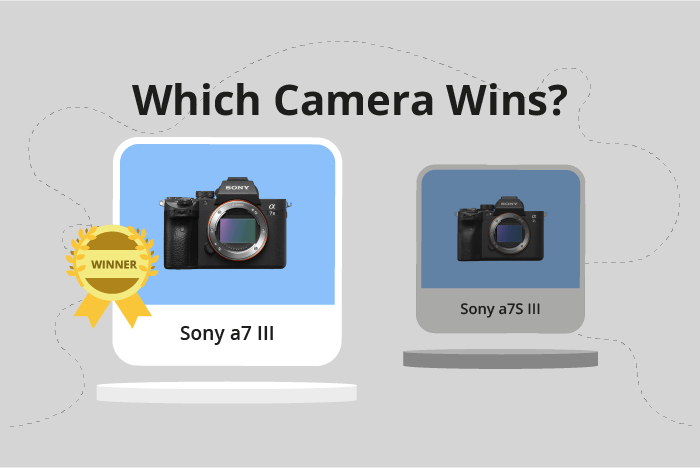Sony a7 III vs a7S III Comparison
Sony a7 III

Sony a7S III

The Sony a7 III outperforms the Sony a7S III with a score of 81 compared to 74. Both cameras share similarities as mirrorless models, announced in 2018 and 2020, respectively. The a7 III takes the lead with a lighter weight of 650g (1.43lbs) and smaller dimensions of 127 x 96 x 74mm, making it more portable. Additionally, it has a lower launch price of $2000, which is more budget-friendly than the a7S III’s $3499.
However, the a7S III has its advantages, such as a more recent release year, offering potentially updated technology. Ultimately, the Sony a7 III proves to be the better choice for those seeking a more affordable and compact option, while the a7S III may cater to those who prioritize newer models.
Sony a7 III vs a7S III Overview and Optics
The Sony a7 III outperforms the Sony a7S III in optics with a score of 81/100 compared to the a7S III’s 69/100. Both cameras share several specifications, including a 10 fps shooting speed, a CMOS sensor, a full-frame sensor size, the Sony FE lens mount, and image stabilization.
The a7 III’s higher score stems from its superior 24.2-megapixel sensor, which offers more resolution than the 12.1-megapixel sensor found in the a7S III. This results in sharper, more detailed images. Additionally, the a7 III has a Bionz X processor and a DXOMARK sensor score of 96, indicating better overall image quality.
On the other hand, the a7S III has a Bionz XR processor, which is a newer and faster processor compared to the Bionz X in the a7 III. However, this advantage does not translate into a higher optics score, as the lower megapixel count and DXOMARK sensor score of 86 limit the a7S III’s overall image quality.
In terms of optics, the Sony a7 III is the clear winner with a higher resolution sensor and better DXOMARK sensor score, resulting in superior image quality. While the a7S III has a newer processor, it does not compensate for its lower megapixel count and DXOMARK sensor score. Therefore, photographers seeking the best optics should opt for the Sony a7 III.
Sony a7 III vs a7S III Video Performance
Both cameras share certain specifications, such as a maximum video resolution of 4K and dimensions of 3840 x 2160. Only the a7 III has built-in time-lapse functionality.
The a7S III’s superiority in video performance is primarily due to its higher maximum video frame rate of 120fps, compared to the a7 III’s 30fps. This allows the a7S III to capture smoother and more detailed slow-motion footage, making it a more versatile option for videographers. The higher frame rate also contributes to its better overall video score.
On the other hand, the Sony a7 III still offers decent video performance with its 4K resolution and 30fps frame rate. While it may not be as advanced as the a7S III in this aspect, it remains a capable camera for those who do not require the higher frame rate for their video projects.
Sony a7 III vs a7S III Features and Benefits
The Sony a7S III emerges as the winner in the features comparison, scoring 83/100, while the Sony a7 III follows closely with a score of 81/100. Both cameras share several common specifications, including a 3-inch screen size, the presence of a touchscreen and flip screen, and the absence of GPS. Additionally, both cameras come equipped with WIFI and Bluetooth capabilities.
The Sony a7S III stands out with its higher screen resolution of 1,440,000 dots, compared to the Sony a7 III’s 921,600 dots. This difference provides the a7S III with a sharper and clearer display, allowing for better image preview and easier menu navigation.
On the other hand, the Sony a7 III, despite its slightly lower feature score, remains a strong contender. It boasts similar core features as the a7S III, making it a viable choice for photographers and videographers who prioritize other factors, such as price or specific lens compatibility.
In comparing the Sony a7 III and the Sony a7S III, both cameras offer impressive features, with the a7S III taking a slight lead due to its superior screen resolution. However, the a7 III remains a valuable option for those who require a high-quality camera without needing the added advantage of the a7S III’s screen resolution. Ultimately, the choice between these two cameras depends on individual preferences and specific requirements for each user.
Sony a7 III vs a7S III Storage and Battery
The Sony a7S III and Sony a7 III perform well in storage and battery. Both cameras have two memory card slots and utilize the NP-FZ100 battery type. They share compatibility with SD, SDHC, and SDXC memory cards.
The a7S III excels in storage options, accepting UHS-II compatible SD cards and CFexpress Type A cards, offering faster read and write speeds. Both models have USB charging, providing more convenience and flexibility for users.
On the other hand, the a7 III boasts a longer battery life of 750 shots, compared to the a7S III’s 600 shots. This advantage may be significant for photographers who prioritize shooting time over storage options.
Considering these factors, the Sony a7S III is superior in terms of storage capabilities and charging options, while the Sony a7 III offers greater battery life. Users should weigh their priorities when choosing between these two cameras.
Alternatives to the Sony a7 III and a7S III
Are you still undecided about which camera is right for you? Have a look at these popular comparisons that feature the Sony a7 III or the Sony a7S III:

